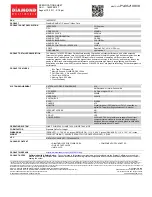
108Mbps SuperG Wireless PCI Adapter
6
Wireless Basics
Wireless products are based on industry standards to provide easy-to-use and compatible high-
speed wireless connectivity within your home or business. Strictly adhering to the 802.11b and
802.11g standards, our wireless family of products will allow you to access the data you want,
when and where you want it. No longer will you be limited to one location or forced to run new
wiring through your home or office. You will be able to enjoy the freedom that wireless networking
delivers.
A Wireless LAN (WLAN) is a cellular computer network that transmits and receives data with radio
signals instead of wires. Wireless LANs are used increasingly in both home and office
environments. Innovative ways to utilize WLAN technology are helping people to work and
communicate more efficiently. Increased mobility and the absence of cabling and other fixed
infrastructure have proven to be beneficial for many users.
Wireless users can use the same network applications they use on an Ethernet LAN. Wireless
card cards used on laptop and desktop systems, support the same protocols as Ethernet card
cards. For most users, there is no noticeable functional difference between a wired Ethernet
desktop computer and a wireless computer equipped with a wireless card other than the added
benefit of the ability to roam within the wireless-cell. Under many circumstances, it may be
desirable for mobile network devices to link to a conventional Ethernet LAN in order to use servers,
printers or an Internet connection supplied through the wired LAN. A Wireless Access Point (AP) is
a device used to provide this link. Your new
108Mbps SuperG Wireless PCI Adapter
can
connect to an 802.11b/g AP, as well as other computers that have an 802.11b/g WLAN card
installed.
People use wireless LAN technology for many different purposes:
Mobility
- Productivity increases when people have access to data in any location within the
operating range of the WLAN. Ad-hoc management decisions based on real-time information can
significantly improve worker efficiency.
Low Implementation Costs
- WLANs are easy to set up, manage, change and relocate.
Networks that frequently change, both physically and logically, can benefit from WLANs’ ease of
implementation. WLANs can operate in locations where installation of wiring may be impractical.
Furthermore, IEEE standardization facilitates interoperability of all WLAN devices that conform to
the 802.11b or 802.11g sets of standards.
Installation Speed and Simplicity
- Installing a wireless LAN system can be fast and easy and
can eliminate the need to pull cable through walls and ceilings.
Installation Flexibility
- Wireless technology allows the network to go where wires cannot go.
Reduced Cost-of-Ownership
- While the initial investment required for wireless LAN hardware
might be higher than the cost of wired LAN hardware, overall installation expenses and life-cycle
costs will be significantly lower. Long-term cost benefits are greatest in dynamic environments
requiring frequent moves, adds, and changes.
Scalability
- Wireless LAN systems can be configured in a variety of topologies to meet the needs
of specific applications and installations. Configurations are easily changed and range from peer-
to-peer networks suitable for a small number of users to full infrastructure networks of thousands
of users that allow roaming over a broad area.
Standards - Based Technology
The IEEE 802.11g standard designates that devices operate at an optimal data rate of 54
Megabits per second. This means you will be able to transfer large files quickly or even watch a
movie in MPEG format over your network without noticeable delays. This technology works by
transmitting high-speed digital data over a radio wave utilizing
OFDM
(Orthogonal Frequency







































